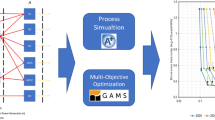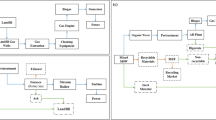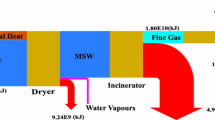Abstract
Thermochemical conversions of the combustible components of municipal solid waste (MSW) minimize the emissions and net effects of greenhouse gas from open incineration, landfill and other associated challenges of traditional MSW management. The thermochemical conversions such as incineration, pyrolysis, and gasification offer a cleaner approach to waste-to-energy/chemical for sustainable MSW management but cost implications are of research interest. Aspen Plus® Model was used to simulate the gasification processes to produce hydrogen-rich syngas from pre-treated MSW. The economic analysis of the system was examined. The economic indices considered were total capital costs (TCC), working capital and operating cost to evaluate the performance of the system. The results of quantitative economic evaluation measurements were net return (NR) of $0.20 million, a rate of return on investment (ROI) of 27.88%, payback time (PBP) of 2.30 years, a net present value (NPV) of $1.11 million and a discounted cash flow rate of return (DCFROR) of 24.80% and 28.20%, respectively. The results of the economic evaluations revealed that some findings of the economic benefits of the thermochemical system selected would be viable if the costs of handling MSW were considered and quantified into the cost analysis.











Similar content being viewed by others
Data availability
The datasets generated during the study are available from the corresponding author on reasonable request.
References
Abu Qdais HA (2007) Techno-economic assessment of municipal solid waste management in Jordan. Waste Manag 27(11):1666–1672. https://doi.org/10.1016/j.wasman.2006.08.004
Athanassiou M, Zabaniotou A (2008) Techno-economic assessment of recycling practices of municipal solid wastes in Cyprus. J Clean Prod 16(14):1474–1483. https://doi.org/10.1016/j.jclepro.2007.09.001
Imam A, Mohammed B, Wilson DC, Cheeseman CR (2008) Solid waste management in Abuja. Niger Waste Manag 28(2):468–472. https://doi.org/10.1016/j.wasman.2007.01.006
Arafat HA, Jijakli K (2013) Modeling and comparative assessment of municipal solid waste gasification for energy production. Waste Manag 33(8):1704–1713. https://doi.org/10.1016/j.wasman.2013.04.008
Ogwueleka TC (2013) Survey of household waste composition and quantities in Abuja, Nigeria. Resour Conserv Recycl 77:52–60. https://doi.org/10.1016/j.resconrec.2013.05.011
Edjabou ME, Jensen MB, Götze R, Pivnenko K, Petersen C, Scheutz C, Astrup TF (2015) Municipal solid waste composition: sampling methodology, statistical analyses, and case study evaluation. Waste Manag 36:12–23. https://doi.org/10.1016/j.wasman.2014.11.009
Hla SS, Roberts D (2015) Characterisation of chemical composition and energy content of green waste and municipal solid waste from Greater Brisbane, Australia. Waste Manag 41:12–19. https://doi.org/10.1016/j.wasman.2015.03.039
Su H, Kanchanatip E, Wang D, Zheng R, Huang Z, Chen Y, Mubeen I, Yan M (2020) Production of H2-rich syngas from gasification of unsorted food waste in supercritical water. Waste Manag 102:520–527. https://doi.org/10.1016/j.wasman.2019.11.018
Götze R, Boldrin A, Scheutz C, Astrup TF (2016) Physico-chemical characterisation of material fractions in household waste: overview of data in literature. Waste Manag 49:3–14. https://doi.org/10.1016/j.wasman.2016.01.008
Götze R, Pivnenko K, Boldrin A, Scheutz C, Astrup TF (2016) Physico-chemical characterisation of material fractions in residual and source-segregated household waste in Denmark. Waste Manag 54:13–26. https://doi.org/10.1016/j.wasman.2016.05.009
Ramos A, Berzosa J, Espí J, Clarens F, Rouboa A (2020) Life cycle costing for plasma gasification of municipal solid waste: a socio-economic approach. Energy Convers Manag 209:112508. https://doi.org/10.1016/j.enconman.2020.112508
Makarenko N, Budak O (2017) Waste management in Ukraine: Municipal solid waste landfills and their impact on rural areas. Ann Agrar Sci 15(1):80–87. https://doi.org/10.1016/j.aasci.2017.02.009
Li Y, Zhang H, Shao L, Zhou X, He P (2019) Impact of municipal solid waste incineration on heavy metals in the surrounding soils by multivariate analysis and lead isotope analysis. J Environ Sci 82:47–56. https://doi.org/10.1016/j.jes.2019.02.020
Li H-Y, Gao P-P, Ni H-G (2019) Emission characteristics of parent and halogenated PAHs in simulated municipal solid waste incineration. Sci Total Environ 665:11–17. https://doi.org/10.1016/j.scitotenv.2019.02.002
Chen S, Huang J, Xiao T, Gao J, Bai J, Luo W, Dong B (2020) Carbon emissions under different domestic waste treatment modes induced by garbage classification: case study in pilot communities in Shanghai. China Sci Total Environ 717:137193. https://doi.org/10.1016/j.scitotenv.2020.137193
Zhou Q, Yang J, Liu M, Liu Y, Sarnat S, Bi J (2018) Toxicological risk by inhalation exposure of air pollution emitted from China’s municipal solid waste incineration. Environ Sci Technol 52(20):1149011499. https://doi.org/10.1021/acs.est.8b03352
Mendes MR, Aramaki T, Hanaki K (2004) Comparison of the environmental impact of incineration and landfilling in São Paulo City as determined by LCA. Resour Conserv Recycl 41(1):47–63. https://doi.org/10.1016/j.resconrec.2003.08.003
Cherubini F, Bargigli S, Ulgiati S (2009) Life cycle assessment (LCA) of waste management strategies: landfilling, sorting plant and incineration. Energy 34(12):2116–2123. https://doi.org/10.1016/j.energy.2008.08.023
Pujara Y, Pathak P, Sharma A, Govani J (2019) Review on Indian municipal solid waste management practices for reduction of environmental impacts to achieve sustainable development goals. J Environ Manag 248:109238. https://doi.org/10.1016/j.jenvman.2019.07.009
Assamoi B, Lawryshyn Y (2012) The environmental comparison of landfilling vs. incineration of MSW accounting for waste diversion. Waste Manag 32(5):1019–1030. https://doi.org/10.1016/j.wasman.2011.10.023
Rathore P, Sarmah SP (2019) Modeling transfer station locations considering source separation of solid waste in urban centers: a case study of Bilaspur city, India. J Clean Prod 211:44–60. https://doi.org/10.1016/j.jclepro.2018.11.100
Norbu T, Visvanathan C, Basnayake B (2005) Pretreatment of municipal solid waste prior to landfilling. Waste Manag 25(10):997–1003. https://doi.org/10.1016/j.wasman.2005.06.006
Trubetskaya A, Leahy JJ, Yazhenskikh E, Müller M, Layden P, Johnson R, Ståhl K, Monaghan RFD (2019) Characterization of woodstove briquettes from torrefied biomass and coal. Energy 171:853–865. https://doi.org/10.1016/j.energy.2019.01.064
Gomaa MR, Mustafa RJ, Al-Dmour N (2020) Solar thermochemical conversion of carbonaceous materials into syngas by co-gasification. J Clean Prod 248:119185. https://doi.org/10.1016/j.jclepro.2019.119185
Adefeso IB (2018) Techno-economic analysis of a gasification system using refuse-derived fuel from municipal solid waste. Cape Peninsula University of Technology, Cape Town
Liakakou ET, Vreugdenhil BJ, Cerone N, Zimbardi F, Pinto F, André R, Marques P, Mata R, Girio F (2019) Gasification of lignin-rich residues for the production of biofuels via syngas fermentation: comparison of gasification technologies. Fuel 251:580–592. https://doi.org/10.1016/j.fuel.2019.04.081
Cao Y, Wang Q, Du J, Chen J (2019) Oxygen-enriched air gasification of biomass materials for high-quality syngas production. Energy Convers Manag 199:111628. https://doi.org/10.1016/j.enconman.2019.05.054
AlNouss A, McKay G, Al-Ansari T (2020) Production of syngas via gasification using optimum blends of biomass. J Clean Prod 242:118499. https://doi.org/10.1016/j.jclepro.2019.118499
Zheng X, Ying Z, Wang B, Chen C (2018) Hydrogen and syngas production from municipal solid waste (MSW) gasification via reusing CO2. Appl Therm Eng 144:242–247. https://doi.org/10.1016/j.applthermaleng.2018.08.058
Fuel Cells Bulletin News (2019) South Africa boosting role of hydrogen and fuel cells in economy. Fuel Cells Bull 2019(1):14–15. https://doi.org/10.1016/S1464-2859(19)30035-5
Bachmann TM, Carnicelli F, Preiss P (2019) Life cycle assessment of domestic fuel cell micro combined heat and power generation: exploring influential factors. Int J Hydrogen Energy 44(7):3891–3905. https://doi.org/10.1016/j.ijhydene.2018.12.076
Santos RGd, Alencar AC (2019) Biomass-derived syngas production via gasification process and its catalytic conversion into fuels by fischer tropsch synthesis: a review. Int J Hydrogen Energy. https://doi.org/10.1016/j.ijhydene.2019.07.133
Ren J, Liu Y-L, Zhao X-Y, Cao J-P (2020) Methanation of syngas from biomass gasification: an overview. Int J Hydrogen Energy 45(7):4223–4243. https://doi.org/10.1016/j.ijhydene.2019.12.023
Thakare S, Nandi S (2016) Study on potential of gasification technology for municipal solid waste (MSW) in Pune City. Energy Proced 90:509–517. https://doi.org/10.1016/j.egypro.2016.11.218
Singh RP, Tyagi VV, Allen T, Ibrahim MH, Kothari R (2011) An overview for exploring the possibilities of energy generation from municipal solid waste (MSW) in Indian scenario. Renew Sustain Energy Rev 15(9):4797–4808. https://doi.org/10.1016/j.rser.2011.07.071
Ng WPQ, Lam HL, Varbanov PS, Klemeš JJ (2014) Waste-to-energy (WTE) network synthesis for municipal solid waste (MSW). Energy Convers Manag 85:866–874. https://doi.org/10.1016/j.enconman.2014.01.004
Alzate-Arias S, Jaramillo-Duque Á, Villada F, Restrepo-Cuestas B (2018) Assessment of government incentives for energy from waste in colombia. Sustainability 10(4):1294. https://doi.org/10.3390/su10041294
Dlamini S, Simatele MD, Serge Kubanza N (2019) Municipal solid waste management in South Africa: from waste to energy recovery through waste-to-energy technologies in Johannesburg. Local Environ 24(3):249–257. https://doi.org/10.1080/13549839.2018.1561656
Stafford WHL (2020) Chapter six—WtE best practices and perspectives in Africa. In: Coelho ST, Sanches Pereira A, Bouille DH et al (eds) Municipal solid waste energy conversion in developing countries. Elsevier, Amsterdam, Netherlands, pp 185–217. https://doi.org/10.1016/B978-0-12-813419-1.00006-1
Adefeso IB, Rabiu AM, Ikhu-Omoregbe DI (2015) Refuse-derived fuel gasification for hydrogen production in high temperature proton exchange membrane fuel cell base CHP system. Waste Biomass Valoriz 6(6):967974. https://doi.org/10.1007/s12649-015-9415-y
Dornburg V, Faaij APC (2001) Efficiency and economy of wood-fired biomass energy systems in relation to scale regarding heat and power generation using combustion and gasification technologies. Biomass Bioenerg 21(2):91–108. https://doi.org/10.1016/S0961-9534(01)00030-7
Farzaneh-Kord V, Khoshnevis AB, Arabkoohsar A, Deymi-Dashtebayaz M, Aghili M, Khatib M, Kargaran M, Farzaneh-Gord M (2016) Defining a technical criterion for economic justification of employing CHP technology in city gate stations. Energy 111:389–401. https://doi.org/10.1016/j.energy.2016.05.122
Liu A, Ren F, Lin WY, Wang J-Y (2015) A review of municipal solid waste environmental standards with a focus on incinerator residues. Int J Sustain Built Environ 4(2):165–188. https://doi.org/10.1016/j.ijsbe.2015.11.002
Ramos A, Monteiro E, Silva V, Rouboa A (2018) Co-gasification and recent developments on waste-to-energy conversion: a review. Renew Sustain Energy Rev 81:380–398. https://doi.org/10.1016/j.rser.2017.07.025
Mayer F, Bhandari R, Gäth S (2019) Critical review on life cycle assessment of conventional and innovative wasteto-energy technologies. Sci Total Environ 672:708–721. https://doi.org/10.1016/j.scitotenv.2019.03.449
Jouhara H, Czajczyńska D, Ghazal H, Krzyżyńska R, Anguilano L, Reynolds AJ, Spencer N (2017) Municipal waste management systems for domestic use. Energy 139:485–506. https://doi.org/10.1016/j.energy.2017.07.162
Liu J, Liu Y, Sun W (2017) Greenhouse gas emissions from different municipal solid waste management scenarios in China: based on carbon and energy flow analysis. Waste Manag 68:653–661. https://doi.org/10.1016/j.wasman.2017.06.020
Majeed A, Batool S, Chaudhry M (2018) Environmental quantification of the existing waste management system in a developing world municipality using EaseTech: the case of Bahawalpur. Pak Sustain 10(7):2424. https://doi.org/10.3390/su10072424
McIlveen-Wright DR, Huang Y, Rezvani S, Redpath D, Anderson M, Dave A, Hewitt NJ (2013) A technical and economic analysis of three large scale biomass combustion plants in the UK. Appl Energy 112:396–404. https://doi.org/10.1016/j.apenergy.2012.12.051
Chacartegui R, Carvalho M, Abrahão R, Becerra J (2015) Analysis of a CHP plant in a municipal solid waste landfill in the South of Spain. Appl Therm Eng 91:706–717. https://doi.org/10.1016/j.applthermaleng.2015.08.069
Farhad S, Hamdullahpur F, Yoo Y (2010) Performance evaluation of different configurations of biogas-fuelled SOFC micro-CHP systems for residential applications. Int J Hydrogen Energy 35(8):3758–3768. https://doi.org/10.1016/j.ijhydene.2010.01.052
Najafi B, Haghighat Mamaghani A, Rinaldi F, Casalegno A (2015) Long-term performance analysis of an HT-PEM fuel cell based micro-CHP system: operational strategies. Appl Energy 147:582–592. https://doi.org/10.1016/j.apenergy.2015.03.043
Gandiglio M, Lanzini A, Santarelli M, Leone P (2014) Design and optimization of a proton exchange membrane fuel cell CHP system for residential use. Energy Build 69:381–393. https://doi.org/10.1016/j.enbuild.2013.11.022
Chandan A, Hattenberger M, El-kharouf A, Du S, Dhir A, Self V, Pollet BG, Ingram A, Bujalski W (2013) High temperature (HT) polymer electrolyte membrane fuel cells (PEMFC)—a review. J Power Sour 231:264278. https://doi.org/10.1016/j.jpowsour.2012.11.126
Bujlo P, Pasupathi S, Ulleberg Ø, Scholta J, Nomnqa MV, Rabiu A, Pollet BG (2013) Validation of an externally oilcooled 1 kWel HT-PEMFC stack operating at various experimental conditions. Int J Hydrogen Energy 38(23):9847–9855. https://doi.org/10.1016/j.ijhydene.2013.05.174
Hamad TA, Agll AA, Hamad YM, Bapat S, Thomas M, Martin KB, Sheffield JW (2014) Study of a molten carbonate fuel cell combined heat, hydrogen and power system. Energy 75:579–588. https://doi.org/10.1016/j.energy.2014.08.020
Mikalsen R, Wang YD, Roskilly AP (2009) A comparison of Miller and Otto cycle natural gas engines for small scale CHP applications. Appl Energy 86(6):922–927. https://doi.org/10.1016/j.apenergy.2008.09.021
Korsgaard AR, Nielsen MP, Kær SK (2008) Part one: a novel model of HTPEM-based micro-combined heat and power fuel cell system. Int J Hydrogen Energy 33(7):1909–1920. https://doi.org/10.1016/j.ijhydene.2008.01.009
Korsgaard AR, Nielsen MP, Kær SK (2008) Part two: Control of a novel HTPEM-based micro combined heat and power fuel cell system. Int J Hydrogen Energy 33(7):1921–1931. https://doi.org/10.1016/j.ijhydene.2008.01.008
Arsalis A (2019) A comprehensive review of fuel cell-based micro-combined-heat-and-power systems. Renew Sustain Energy Rev 105:391–414. https://doi.org/10.1016/j.rser.2019.02.013
Bessarabov D, Human G, Kruger AJ, Chiuta S, Modisha PM, du Preez SP, Oelofse SP, Vincent I, Van Der Merwe J, Langmi HW, Ren J, Musyoka NM (2017) South African hydrogen infrastructure (HySA infrastructure) for fuel cells and energy storage: overview of a projects portfolio. Int J Hydrogen Energy 42(19):13568–13588. https://doi.org/10.1016/j.ijhydene.2016.12.140
Barrett S (2013) HySA Infrastructure: producing and using hydrogen for energy in South Africa. Fuel Cells Bull 2013(6):12–17. https://doi.org/10.1016/S1464-2859(13)70239-6
Pollet BG, Pasupathi S, Swart G, Mouton K, Lototskyy M, Williams M, Bujlo P, Ji S, Bladergroen BJ, Linkov V (2014) Hydrogen South Africa (HySA) systems competence centre: mission, objectives, technological achievements and breakthroughs. Int J Hydrogen Energy 39(8):3577–3596. https://doi.org/10.1016/j.ijhydene.2013.11.116
HySA Systems unveils first hydrogen forklift, refueling station in SA (2016) HySA systems unveils first hydrogen forklift, refueling station in SA. Fuel Cells News Bull 2016(4):4–4. https://doi.org/10.1016/S1464-2859(16)30075-X
Gu J, Renwick N, Xue L (2018) The BRICS and Africa’s search for green growth, clean energy and sustainable development. Energy Policy 120:675–683. https://doi.org/10.1016/j.enpol.2018.05.028
Nomnqa M, Ikhu-Omoregbe D, Rabiu A (2016) Parametric analysis of a high temperature PEM fuel cell based microcogeneration system. Int J Chem Eng 2016:1–14. https://doi.org/10.1155/2016/4596251
Pollet BG, Pasupathi S, Swart G, Lototskyy M, Williams M, Bujlo P, Ji S, Linkov V, Bladergroen BJ (2014) Hydrogen and fuel cell technologies at the hydrogen South Africa (HySA) systems competence centre. Platin Met Rev 58(2):68–81. https://doi.org/10.1595/147106714X679287
Sharaf OZ, Orhan MF (2014) An overview of fuel cell technology: fundamentals and applications. Renew Sustain Energy Rev 32:810–853. https://doi.org/10.1016/j.rser.2014.01.012
Bessarabov D, van Niekerk F, van der Merwe F, Vosloo M, North B, Mathe M (2012) Hydrogen infrastructure within HySA national program in South Africa: road map and specific needs. Energy Proced 29(Supplement C):42–52. https://doi.org/10.1016/j.egypro.2012.09.007
Pollet BG (2013) Mission and objectives of the hydrogen South Africa (HySA) systems competence centre. Fuel Cells Bull 2013(10):10–17. https://doi.org/10.1016/S1464-2859(13)70360-2
Barrett S (2014) Dissecting ‘HySA.’ Renew Energy Focus 15(1):40–44. https://doi.org/10.1016/S1755-0084(14)70024-9
Barrett S (2013) HySA/Catalysis: creating opportunities from South Africa’s mineral wealth. Fuel Cells Bull 2013(11):12–15. https://doi.org/10.1016/S1464-2859(13)70391-2
Schefflan R (2011) Teach yourself the basics of aspen plus, vol 1. AIChe and Wiley & Sons Inc., Hoboken
Towler GP, Sinnott RK, Books24x I (2013) Chemical engineering design: principles, practice and economics of plant and process design, vol Book. Butterworth-Heinemann, Waltham
Demis S, Tapali JG, Papadakis VG (2015) Plant design and economics of rice husk ash exploitation as a pozzolanic material. Waste Biomass Valoriz 6(5):843–853. https://doi.org/10.1007/s12649-015-9412-1
Green D, Southard MZ (2019) Perry’s chemical engineers’ handbook, 9th edn. McGraw-Hill Education, UK
Towler G, Sinnott RK (2012) Chemical engineering design: principles, practice and economics of plant and process design, vol Book. Butterworth-Heinemann, New York, USA
Peters MS, Timmerhaus KD, West RE (2003) Plant design and economics for chemical engineers, vol Book. McGraw-Hill, New York
Li Y-C, Liu Y-F, Chu C-Y, Chang P-L, Hsu C-W, Lin P-J, Wu S-Y (2012) Techno-economic evaluation of biohydrogen production from wastewater and agricultural waste. Int J Hydrogen Energy 37(20):15704–15710. https://doi.org/10.1016/j.ijhydene.2012.05.043
Wood SR, Rowley PN (2011) A techno-economic analysis of small-scale, biomass-fuelled combined heat and power for community housing. Biomass Bioenerg 35(9):3849–3858. https://doi.org/10.1016/j.biombioe.2011.04.040
Kozlova M, Fleten S-E, Hagspiel V (2019) Investment timing and capacity choice under rate-of-return regulation for renewable energy support. Energy 174:591–601. https://doi.org/10.1016/j.energy.2019.02.175
Bilal B, Mehjabeen RJ (2019) The investment-return-environment triangle in cleaner production projects. Sustain Prod Consum 19:161–168. https://doi.org/10.1016/j.spc.2019.03.007
Kousky C, Ritchie L, Tierney K, Lingle B (2019) Return on investment analysis and its applicability to community disaster preparedness activities: calculating costs and returns. Int J Disaster Risk Reduct 41:101296. https://doi.org/10.1016/j.ijdrr.2019.101296
Perry RH, Green DW (2008) Perry’s chemical engineers’ handbook, vol Book. McGraw-Hill, New York
Basu P, Books24x I (2013) Biomass gasification, pyrolysis, and torrefaction: practical design and theory, vol Book. Academic Press, London
Porcu A, Sollai S, Marotto D, Mureddu M, Ferrara F, Pettinau A (2019) Techno-economic analysis of a small-scale biomass-to-energy BFB gasification-based system. Energies 12(3):494. https://doi.org/10.3390/en12030494
Rojas-Vallejos J, Lastuka A (2020) The income inequality and carbon emissions trade-off revisited. Energy Policy 139:111302. https://doi.org/10.1016/j.enpol.2020.111302
Weiss M, Irrgang L, Kiefer AT, Roth JR, Helmers E (2020) Mass- and power-related efficiency trade-offs and CO2 emissions of compact passenger cars. J Clean Prod 243:118326. https://doi.org/10.1016/j.jclepro.2019.118326
Muresan M, Cormos C-C, Agachi P-S (2013) Techno-economical assessment of coal and biomass gasification-based hydrogen production supply chain system. Chem Eng Res Des 91(8):1527–1541. https://doi.org/10.1016/j.cherd.2013.02.018
Author information
Authors and Affiliations
Corresponding author
Additional information
Publisher's Note
Springer Nature remains neutral with regard to jurisdictional claims in published maps and institutional affiliations.
Supplementary Information
Below is the link to the electronic supplementary material.
Rights and permissions
Springer Nature or its licensor (e.g. a society or other partner) holds exclusive rights to this article under a publishing agreement with the author(s) or other rightsholder(s); author self-archiving of the accepted manuscript version of this article is solely governed by the terms of such publishing agreement and applicable law.
About this article
Cite this article
Adefeso, I.B., Ikhu-Omoregbe, D.I. & Isa, Y.M. Economic evaluation of thermochemical conversion of municipal solid waste to syngas: a case study of Cape Town municipality. J Mater Cycles Waste Manag 25, 1179–1190 (2023). https://doi.org/10.1007/s10163-022-01548-w
Received:
Accepted:
Published:
Issue Date:
DOI: https://doi.org/10.1007/s10163-022-01548-w




